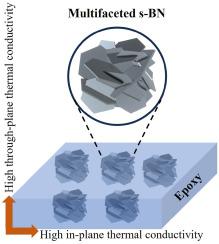填充烧结多面氮化硼的环氧树脂复合薄膜,用于热学和介电应用
IF 5.1
2区 材料科学
Q1 MATERIALS SCIENCE, CERAMICS
引用次数: 0
摘要
电子设备的微型化导致功率密度和功能集成度的提高,从而导致热量迅速积聚,对运行稳定性和使用寿命产生不利影响。为解决电子封装应用中的热管理问题,具有优异导热性和绝缘性能的介电复合薄膜备受青睐。六方氮化硼(h-BN)具有出色的热导率、绝缘性能和化学稳定性,是此类复合材料的理想填料。然而,h-BN 固有的板状结构会导致显著的各向异性以及与聚合物的混溶性差,从而限制了热量的均匀传导。本研究提出了一种高温烧结方法,可将片状 h-BN 板转化为不规则的多面颗粒。这种转变降低了热各向异性,创造了均匀的热传导途径。与原始的 h-BN/epoxy 复合材料相比,烧结后的 BN/Epoxy (s-BN/EP)复合薄膜具有优异的热导率,面内热导率提高了 36% 达到 6.0 W m-1 K-1,面间热导率提高了 39% 达到 1.2 W m-1 K-1。此外,s-BN/EP 薄膜还能在 5 GHz 频率下保持较低的介电常数(Dk,3.22)和介电损耗(Df,0.015)。这种创新方法大大推动了高性能绝缘聚合物复合材料的发展,为高功率密度电子封装的热管理提供了一种前景广阔的解决方案。本文章由计算机程序翻译,如有差异,请以英文原文为准。

Epoxy composite films filled with sintered multifaceted boron nitride for thermal and dielectric applications
The miniaturization of electronic devices has led to an increase in power density and functional integration, resulting in rapid heat accumulation that adversely affects operational stability and service life. Dielectric composite films with excellent thermal conductivity and insulating properties are highly desired for addressing thermal management issues in electronic packaging applications. Hexagonal boron nitride (h-BN) is a promising filler for such composites due to its outstanding thermal conductivity, insulating properties, and chemical stability. However, the inherent platelike structure of h-BN causes significant anisotropy and poor miscibility with polymers, limiting the uniform conduction of heat. This study proposes a high-temperature sintering method that transforms flaky h-BN plates into irregular multifaceted particles. This transformation reduces thermal anisotropy and creates uniform heat conduction pathways. The resulting sintered BN/Epoxy (s-BN/EP) composite films exhibit exceptional thermal conductivity, with in-plane thermal conductivity increased by 36 % to 6.0 W m−1 K−1 and through-plane thermal conductivity increased by 39 % to 1.2 W m−1 K−1 compared to pristine h-BN/epoxy composites. Moreover, s-BN/EP films could maintain low dielectric constant (Dk, 3.22) and dielectric loss (Df, 0.015) at 5 GHz. This innovative approach provides a significant advancement in the development of high-performance insulating polymer composites, offering a promising solution for thermal management in high-power-density electronic packaging.
求助全文
通过发布文献求助,成功后即可免费获取论文全文。
去求助
来源期刊

Ceramics International
工程技术-材料科学:硅酸盐
CiteScore
9.40
自引率
15.40%
发文量
4558
审稿时长
25 days
期刊介绍:
Ceramics International covers the science of advanced ceramic materials. The journal encourages contributions that demonstrate how an understanding of the basic chemical and physical phenomena may direct materials design and stimulate ideas for new or improved processing techniques, in order to obtain materials with desired structural features and properties.
Ceramics International covers oxide and non-oxide ceramics, functional glasses, glass ceramics, amorphous inorganic non-metallic materials (and their combinations with metal and organic materials), in the form of particulates, dense or porous bodies, thin/thick films and laminated, graded and composite structures. Process related topics such as ceramic-ceramic joints or joining ceramics with dissimilar materials, as well as surface finishing and conditioning are also covered. Besides traditional processing techniques, manufacturing routes of interest include innovative procedures benefiting from externally applied stresses, electromagnetic fields and energetic beams, as well as top-down and self-assembly nanotechnology approaches. In addition, the journal welcomes submissions on bio-inspired and bio-enabled materials designs, experimentally validated multi scale modelling and simulation for materials design, and the use of the most advanced chemical and physical characterization techniques of structure, properties and behaviour.
Technologically relevant low-dimensional systems are a particular focus of Ceramics International. These include 0, 1 and 2-D nanomaterials (also covering CNTs, graphene and related materials, and diamond-like carbons), their nanocomposites, as well as nano-hybrids and hierarchical multifunctional nanostructures that might integrate molecular, biological and electronic components.
 求助内容:
求助内容: 应助结果提醒方式:
应助结果提醒方式:


